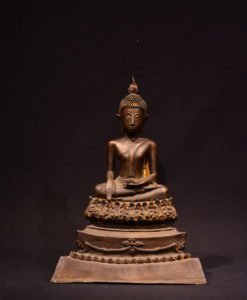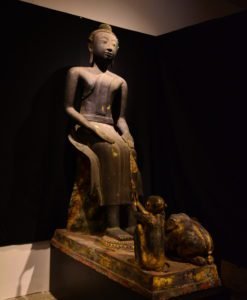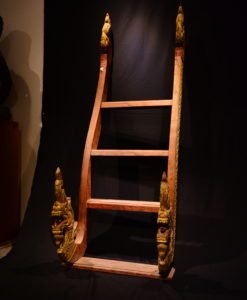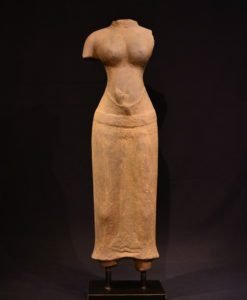Angkor Wat Period Sandstone Linga – Symbol of Shiva’s Cosmic Power, 60 cm
This remarkable linga, crafted from the finest sandstone, is a true representation of the spiritual and artistic richness of the Angkor Wat period (1113-1150 CE). Standing at approximately 60 cm in height, this statue is a compelling artifact embodying the abstract nature of Shiva, one of the principal deities in Hinduism. Its simple, cylindrical form without a yoni base sets it apart as a distinctive piece from the era.
ITEM DESCRIPTION
Historical Context and Symbolism
The linga has long been regarded as a profound symbol of Shiva’s cosmic power. Unlike more ornate representations, the simplicity of this linga emphasizes the purity and transcendence of Shiva, representing not just the god’s physical presence but also his creative energy and destructive force in the universe. The absence of a yoni base, commonly seen in many lingas, further underscores the linga’s portrayal of Shiva in his most abstract and divine form.
Lingas were central in Hindu rituals, used as focal points for meditation and worship. The smooth, slightly rounded surface of this statue suggests it may have been the object of ritualistic offerings, where the linga’s polished texture would have been enhanced by repeated contact with hands in prayer or ceremony.
A Legacy Passed Through Generations
This particular linga was passed down through generations, originating from a local governor’s family. Its journey through time, preserved as a valuable heirloom, speaks to the deep reverence it held within the family, perhaps used in private rituals or as a legacy of ancestral worship. Such artifacts are not merely aesthetic objects; they are vessels of history and culture, encapsulating centuries of religious practices and family legacy.
Craftsmanship of the Angkor Wat Period
The craftsmanship of this statue reflects the refined artistry of the Angkor Wat period. During this time, the Khmer Empire saw the construction of monumental temples and intricate carvings that demonstrated the empire’s grandeur. While most sculptures from this period were lavishly detailed, this linga’s simple form is a testament to the elegance of understated craftsmanship, where the focus remains on symbolic meaning rather than ornate decoration.
The use of sandstone as the material for this linga aligns with other examples from the period, demonstrating the Khmer Empire’s skill in stone carving. While it lacks the detailed inscriptions and carvings found in other Angkor Wat sculptures, this plain yet powerful form communicates a profound spiritual message about Shiva’s role in the cosmos.
Ritual and Cultural Significance
Lingas were not just decorative pieces but served a vital function in the religious life of the Khmer people. The linga’s role in temple worship, as part of a larger ensemble of sacred objects, was central to the religious rituals conducted by the Khmer kings and their subjects. The simplicity of this piece suggests it could have been part of a private shrine or a temple’s inner sanctum, reserved for meditative practice and focused spiritual connection with Shiva.
Scholars have noted the integral role of the linga in ritual practices, often involving offerings of water, flowers, and incense. This object’s smooth surface likely made it the perfect medium for such offerings, with its form facilitating the natural flow of ritual substances.
Preserved Condition and Legacy
Despite the wear and tear typical of objects that have been used in religious rituals over centuries, this linga remains in remarkably good condition. Its smooth surface has been polished by countless hands, adding to its historical allure. The small traces of wear speak to its authenticity and continued reverence over generations.
Why Add This Linga to Your Collection?
For collectors of Southeast Asian antiques, this Angkor Wat period linga represents a rare and significant acquisition. Its symbolic importance, historical background, and artistic merit make it a standout piece in any collection. With its rich association with Shiva and its role in ancient Khmer ritual practices, this statue is not only a work of art but a connection to a centuries-old legacy of faith and culture.
Whether displayed in a private collection or as part of a museum-quality exhibit, this linga is a tangible link to the past, offering a glimpse into the spiritual and cultural life of the Khmer Empire during its zenith.
References:
-
Coe, M. D. (2003). Angkor and the Khmer Civilization. Thames & Hudson.
-
Henshilwood, C., & Dreyfus, R. (2009). Khmer Art and Architecture: The Development of the Linga Symbol in Southeast Asia. Cambridge University Press.
-
Watson, C. (2007). The Art of Cambodia: Sculpture and Architecture. The British Museum Press.
Origin: Cambodia
Period: Angkor Wat
PRODUCT DETAIL
Medium: Sandstone
Dimensions:
Height – cm
Length – cm
Wide – cm
Condition Report: –
Please keep in touch for Price and more information: Mallika1013@gmail.com




















